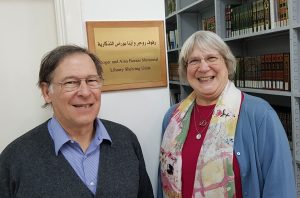
In 2006, Roger and Aina Boraas set up a fund for support of the ACOR Library and designated it for research materials. They and their daughter Miriam and her husband Ralston Deffenbaugh, Jr. have given generously. This fund has allowed ACOR to purchase significant books and journals for the ACOR Library and also made our dream come true to install compressed shelving units in the ACOR Lower Library, thereby providing for future library needs. The family designated this fund as one way for friends and family to honor the memory of Roger Boraas (1926–2014) and Aina Boraas (1922–2018). ACOR expresses our profound gratitude to the Boraas family for their consistent dedication to helping us achieve our mission. Their generosity as donors is the fuel that makes core ACOR operations possible. Below you will find an article about the life and legacy of Roger Boraas, published in ACOR Newsletter Vol. 26.2 (Winter 2014).
Roger Boraas Remembered
by Bert de Vries with Miriam Deffenbaugh and Barbara A. Porter
Roger Boraas was one of ACOR’s founding fathers. He was born in Stillwater, Minnesota on 4 February 1926 and died on 3 December 2014 in Pennsylvania. He was associated with Upsala College in East Orange, New Jersey from 1958 to 1991.
He is survived by his wife Aina, whom he married in 1948, and their children Miriam Deffenbaugh, Marcia Boraas, and Roger Boraas, as well as six grandchildren and many nieces and nephews. In 2006, he received the P. E. Macalister Award from the American Schools of Oriental Research. The following is excerpted from the award citation written by Bert de Vries and augmented by him with new refections.
The P. E. MacAllister Field Archaeology Award honors archaeologists who have made outstanding contributions to ancient Near Eastern and Eastern Mediterranean archaeology and was given to Roger Boraas for his pioneering role in the development of scientific archaeology in Jordan. He demonstrated a life-long dedication to the rigorous and disciplined application of sound scientific methods to archaeological field research, which ranged from Tell Balatah in Palestine to Hesban and Rujm al-Malfouf in Jordan. Specifically, this included his teaching and overseeing of the stratigraphic method of excavation at Hesban, including rigorous excavation procedures, meticulous and faithful recording of field data, and disciplined restriction of interpretations to their logical derivation from evidence in hand.
His legacy in the continuation of that scientific methodology is reflected in the plethora of projects begun by young scholars who graduated from his Hesban “school of stratigraphy.” Roger himself adapted his field manual to the work at Khirbat Iskander in Jordan, where he served as project stratigrapher in the 1982 and 1984 field seasons.
Roger was a pioneer in the transition from the Old Archaeology of the 1930s to 60s to the New Archaeology of the 70s to 90s, and his influence continued to provide methodological substance. He could apply his critical wit with equal ease to the analysis of a confounding soil layer or to a subtle sub-theme in a Pinter play. The archaeological search for understanding how our fellow humans lived came through careful examination of the material evidence. This became clear to all who associated with Roger on the massive seasons at Hesban where he served as the Chief Archaeologist. In 1969, he also directed a small group—including his wife Aina—at the site of Rujm al-Malfouf, which lies in front of the Department of Antiquities’ headquarters in Amman. That was a special season fondly remembered by both of us, and to me Rujm al-Malfouf will always serve as a monument to his involvement in Jordan.
To read this article as it was printed on page 9 of ACOR Newsletter 26.2, click here.
